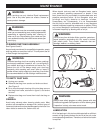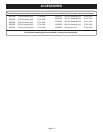
Page 11
CAUTION:
To avoid damaging the motor from overheating, Be
careful not to let your hand cover the air vents.
APPLICATIONS
(Use only for the purposes listed below)
Sanding on wood surfaces.
Removing rust from and sanding steel surfaces.
TURNING THE SANDER ON/OFF
To turn the sander ON, depress the switch button as shown
in Figure 1. Depress the switch button in the opposite
direction to turn the sander OFF.
SANDING
See Figures 6 and 7.
Clamp or otherwise secure the work to prevent it from
moving under your sander.
WARNING:
Unsecured workpieces can be thrown towards the operator
causing injury.
Place sander on workpiece so that all of sanding disc surface
is in contact with workpiece. Start your sander and move it
slowly over workpiece making successive passes in parallel
lines, circles, or crosswise movements. Upon completion of
sanding operation, turn sander off and wait until sanding disc
comes to a complete stop before removing from workpiece.
DO NOT FORCE. The weight of the unit supplies adequate
pressure, so let the sanding disc and sander do the work.
Applying additional pressure only slows the motor, rapidly
wears sanding disc and greatly reduces sander speed.
Excessive pressure will overload the motor causing possible
damage from motor overheating and can result in inferior
work. Any finish or resin on wood may soften from the
frictional heat. Do not allow sanding on one spot too long
as the sander's rapid action may remove too much material,
making the surface uneven.
Extended periods of sanding may tend to overheat the
motor. If this occurs, turn sander off and wait until sanding
disc comes to a complete stop, then remove it from
workpiece. Remove your hand from vent area, remove
sanding disc, then with your hand removed from vent area,
turn sander on and run it free without a load to cool motor.
Flush sanding can be performed with your sander. As
shown in Figure 7, the front edge of your sander allows
flush sanding. Upon completion of sanding operation, turn
sander off and wait until sanding disc comes to a complete
stop before removing from workpiece.
OPERATION
Fig. 7
Fig. 6
















